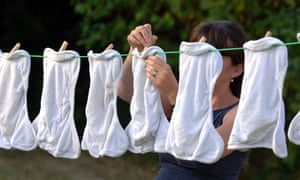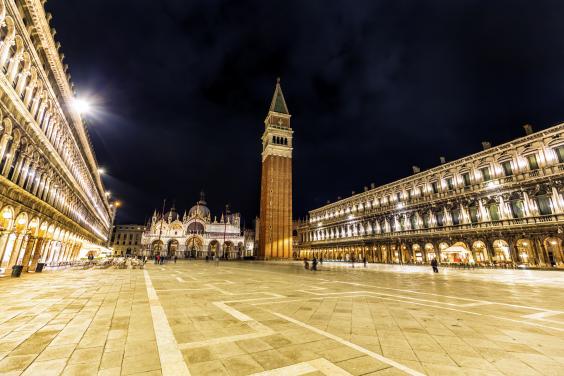Nappy libraries and glass milk bottles: past ideas for a plastic-free future
To emulate forward-thinking Penzance, now plastic-free, we should hark
back to yesteryear. A few choice items could curb a ruinous plastic
habit

I’ve just returned from Penzance, designated the UK’s first plastic-free town by Surfers Against Sewage. This weekend it hosted residents from Aberporth, west Wales, with aspirations to follow suit; shop and cafe owners discussed the best solutions for denting the UK’s annual 3.7m-tonne plastic habit (2.2m of that being packaging). It was an impressive display of what we might refer to as the Dunkirk spirit.
Certainly some of the solutions now on the table are redolent of wartime frugality. Some date back even further. By the end of the year, we may be taking our energy drinks in amphoras. For now, here are some of the nostalgia-tinted front-runners in the charge to go plastic-free.
Glass milk bottles
The first deliveries of milk in glass bottles took place at the end of the 19th century, driven by a rather literal desire for transparency: the customer could see straight away that their milk contained no flotsam or jetsam. But even now we take that as a given, there is plenty to love eco-wise about glass milk bottles. Once rinsed and returned to the doorstep by the consumer, they are collected as part of the morning delivery, taken to a local bottling plant and sanitised, ready to go again. Each glass bottle is used an average of 13 times before being recycled.The triumph here is in the speed of the turnaround. The plastics industry might argue that PET and HDPE – common types of plastic for milk containers – can be collected and successfully recycled into food-grade material. But in practice plastic recycling often falls short. Since China’s new recycling laws came into effect at the start of the year, much foreign waste is being refused. In the UK, domestic capacity for recycling is tiny.
According to Diary UK, doorstep deliveries have risen to near to a million a day, up from 800,000 two years ago. This could be the biggest comeback since Lazarus.

Laundry soap
The last time laundry soap was hot was in the 1920s. Popped into the script of serial radio dramas, it would be liberally referenced by a character (female of course), and lo, the soap opera was born.A revival would spell the end for the moulded mixed-plastic bottles and tubs that laundry detergent relies on. As Rinso is more likely to be found in a museum than a supermarket, try Sapindus soap nuts, produced by a shrub related to the lychee. The real enthusiast can buy a 5kg sack, which should keep you going for a while.
Copper surfaces
In the war against plastic, we’ll soon have picked the low-hanging fruits. But when it comes to the serious stuff, like hospital apparatus and infrastructure, we may need a total material shift. So here’s one that was prized by the Aztecs: copper. Medical researchers working on infection reduction report copper to be hugely effective at killing superbugs. In one study, six items in hospital wards, including surfaces and fittings, were swapped from plastic to copper. There was a 58% reduction in hospital-acquired infections.Water fountains
Michael Gove and Sadiq Khan have been among those to signal their commitment to water fountains in the fight against single-use plastic water bottles (Britons use 7.7bn a year, and fewer than half are recycled).They are an old idea, but don’t necessarily expect them to be in Victorian repro style when they finally arrive. The next-generation water fountains are hands-free bottle-filling stations, ergonomically fashioned to fit water bottles and with sensors that automatically stop the flow of water when the bottle is full. Can’t wait!
Cloth nappies
Every day, 8m disposable nappies are shovelled into the UK’s landfill. That is where – whatever it says on the pack – they will fester for hundreds of years. Some claim to be biodegradable – but that requires oxygen, and there’s not much of that under the ground.The words “cloth nappy” conjure visions of terry squares and oversized pins. But today’s nappy systems offer an assortment of washable and reusable options, made from materials such as bamboo and hemp. There are also “nappy libraries”, which save you the initial outlay, and collection services. About 2.7kg of raw materials are used in a full-time set of reusable nappies, as opposed to 120kg if a child is in disposables. To explore the options, go to Go Real.
• Lucy Siegle is the Observer’s ethical living columnist
http://www.independent.co.uk/travel/news-and-advice/venice-restaurant-bill-charge-meal-tourists-police-osteria-da-luca-st-marks-square-a8172426.html
Restaurant labelled 'rip-off central' in online review
“This is just the latest case of many of this kind. The young people, who are university students in Bologna, made a formal denunciation to the local police station as soon as they got off the train.”
The restaurant has a 1.5 (out of 5) rating on Tripadvisor, with 83 per cent of visitors labelling it “Terrible”.
One user complained: “Just got done eating at this place and the food was very average, wasn’t going to leave a review at all until I got the bill! They added on almost €50 in taxes and tip, these are the hidden fees that they don’t tell you and the service wasn’t that good! I feel scammed.”
Another visitor, who posted a review in December 2017, wrote: “A coke costs €7.50, the lasagne is just a blob of mince sauce and a lettuce leaf, the pizzas are defrosted bases probably supermarket purchased, strong smell of the toilet at our table, the bill was extremely expensive and we highly regret not checking Tripadvisor before entering this restaurant.”
There have been a number of incidents involving tourists alleging that they were ripped off at Venice restaurants in recent months.
In November 2017, a British tourist dubbed a Venice restaurant “horrible and disgusting” after being charged €526 (£463) for lunch for three. The tourist from Birmingham ate with his parents at Trattoria Casanova in the central San Marco district, ordering a spread of food and sharing it between them. Italian restaurants often charge by weight rather than portion, and the restaurant denied any wrongdoing.
Venice mayor Luigi Brugnaro introduced fines last year to dissuade tourists from littering, walking around topless and other acts deemed inappropriate, but also said tourists “need to shell out a bit” when eating in the city, following criticisms of extortionate bills at restaurants.
https://www.washingtonpost.com/posteverything/wp/2015/06/15/how-does-the-weather-work-in-game-of-thrones/?utm_term=.4b623e37de59
How does the weather work in 'Game of Thrones'?
Winter is coming — but why?
An unusual or changing climate is a big deal. George R R Martin’s world bears many similarities to Medieval Europe, where changes in the climate influenced social and economic developments through impacts on water resources, crop development and the potential for famine.
We’re interested in whether Westeros’s climate science adds up, given what we’ve learned about how these things work here on Earth.
It’s not easy to understand the mechanisms driving the climate system, given that we can’t climb into the “Game of Thrones” universe and take measurements ourselves. It’s hard enough to get an accurate picture of what’s driving the world’s climate even with many thousands of thermometers, buoys and satellite readings all plugging data into modern supercomputers — a few old maesters communicating by raven are bound to struggle.
The fundamental difference between our world and that of Westeros is of course the presence of seasons. Here on Earth, seasons are caused by the planet orbiting around the sun, which constantly bombards us with sunlight. However, the amount of sunlight received is not the same throughout the year.
If you imagine the Earth with a long pole through its center (with the top and bottom of the pole essentially the North and the South poles) and then tilt that by 23.5 degrees, the amount of sunlight received in the Northern and the Southern hemispheres will change throughout the year as the Earth orbits the Sun.
Clearly the unnamed planet on which “Game of Thrones” is set is missing this axis tilt — or some other crucial part of Earth’s climate system.
How longer seasons might work
The simplest explanation could be linked to spatial fluctuations in solar radiation (sunlight) received at the surface. A reduction in incoming solar radiation would mean more snow and ice likely remaining on the ground during the summer in Westeros’s far north. Compared to the more absorbent soil or rock, snow reflects more of the sun’s energy back out to space where in effect it cannot warm the Earth‘s surface. So more snow leads to a cooler planet, which means more snow cover on previously snow-free regions, and so on. This process is known as the snow albedo feedback.The collapse of large ice sheets north of the Wall could also rapidly destabilize ocean circulation, reducing northward heat transport and leading to the encroachment of snow and ice southward toward King’s Landing.
To descend into glacial conditions would require a large decrease in solar radiation received at certain locations on the Earth’s surface and likewise an increase would be needed to return to warmer conditions.
This is roughly what happened during the switches between “glacial” and “interglacial” (milder) conditions throughout the past million years on Earth. This is controlled primarily by different orbital configurations known as “Milankovitch cycles,” which affect the seasonality and location of sunlight received on Earth.
However, these cycles are on the order of 23,000 to 100,000 years, whereas “Game of Thrones” seemingly has much shorter cycles of a decade or less.
When winter came back
About 12,900 years ago, there was a much more abrupt climate shift, known as the Younger Dryas, when a spell of near-glacial conditions interrupted a period of gradual rewarming after the last ice age peaked 21,000 years ago. The sudden thawing at the end of this cold spell happened in a matter of decades — a blink of an eye in geological terms — and led to the warm, interglacial conditions we still have today.Various theories have tried to explain why this spike occurred, including the sudden injection of freshwater into the North Atlantic from the outburst of North American glacial lakes, in response to the deglaciation, which destabilized ocean circulation by freshening the water and reducing ocean heat transport to the North Atlantic Ocean, cooling the regional climate.
Less likely explanations include shifts in the jet stream, volcanic eruptions blocking out the sun, or even an asteroid impact.
The shift from the Medieval Warm Period to the Little Ice Age that began around AD 1300 represents a more recent, and more subtle, example of a “quick” climate change. Although the overall temperature change wasn’t too severe — a Northern Hemisphere decrease of around one degree Celcius compared with today — it was enough to cause much harsher winters in Northern Europe.
None of these events indicate the abrupt transitions from long summers to long winters as described in “Game of Thrones” — and they still all happen on a much longer timescale than a Westeros winter. However they do demonstrate how extreme climate shifts are possible even on geologically short timescales.
Regardless of the causes of the long and erratic seasons, winter in Westeros won’t be much fun. It may even make the struggle for the Iron Throne between the various factions seem irrelevant.
Indeed the House of Stark’s motto “winter is coming” may have a lesson for us here on Earth. Anthropogenic climate change is one of the biggest challenges facing humankind today and if left unmitigated the potential environmental impact on society may be far greater than any global recession. Stop worrying about the Iron Throne, everyone, winter is coming.











No comments:
Post a Comment